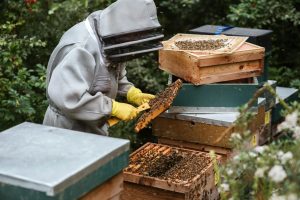Regenerative Farming’s Return: Nourishing Soil, Nourishing Us
As the world continues to face ongoing issues with food production, many are turning to regenerative farming as a solution. This sustainable farming practice focuses on building and nurturing healthy soil, which in turn produces nourishing crops. Regenerative farming not only benefits the environment, but also has a positive impact on human health. In this article, we will explore the concept of regenerative farming and how it is making a comeback in the world of agriculture.
The Basics of Regenerative Farming
Regenerative farming is a holistic approach to land stewardship that focuses on restoring and improving soil health. Unlike conventional farming methods that rely on chemical inputs, regenerative farming works with nature to create a thriving ecosystem. This method involves techniques such as crop rotation, cover cropping, minimal tillage, and the integration of livestock to improve soil health and increase biodiversity.
Crop Rotation and Cover Cropping
One of the key principles of regenerative farming is crop rotation. Instead of planting the same crop in the same field year after year, different crops are rotated to maintain soil health and fertility. This helps to prevent soil depletion and reduces the need for chemical fertilizers. Cover cropping is also an important aspect of regenerative farming, where crops such as legumes and grasses are planted in between cash crops. These cover crops help to suppress weeds, prevent erosion, and add beneficial nutrients to the soil.
Minimal Tillage
Tillage, the practice of turning over and breaking up soil, is often used in conventional farming as a means of controlling weeds and preparing the soil for planting. However, this can be damaging to the soil structure, as it disrupts the natural balance of microorganisms and can lead to erosion. In regenerative farming, minimal tillage is used to reduce soil disturbance and maintain the soil structure. This allows for the soil to hold more water and nutrients, creating a more resilient and healthy ecosystem.
Integrating Livestock
Traditionally, livestock and farming have been separate entities. However, incorporating livestock into regenerative farming has many benefits. Livestock can graze on cover crops and crop residues, adding manure and nutrients back into the soil. They also help to break up the soil, improving aeration and water infiltration. In addition, the manure from livestock provides a natural fertilizer for crops, reducing the need for chemical inputs.
The Environmental Benefits of Regenerative Farming
Regenerative farming has numerous environmental benefits, making it a sustainable choice for agriculture. By focusing on improving soil health, this method reduces soil erosion and increases water retention. This has a positive impact on the surrounding ecosystem, as it helps to prevent water pollution and improves the quality of the air. Regenerative farming also promotes biodiversity, as the use of diverse crops and integration of livestock creates a balanced and robust ecosystem.
The Role of Regenerative Farming in Combatting Climate Change
As our planet grapples with the effects of climate change, the need for sustainable agricultural practices is becoming increasingly urgent. Regenerative farming has been gaining recognition for its potential to combat climate change. By improving soil health and increasing biodiversity, this method helps to sequester carbon from the atmosphere and store it in the soil. In fact, some studies have shown that regenerative farming can actually reverse the effects of climate change by reducing greenhouse gas emissions and increasing carbon sequestration.
Health Benefits of Regenerative Farming
In addition to its environmental benefits, regenerative farming also has a positive impact on human health. By using natural farming methods, crops are more nutrient-dense, providing a greater range of vitamins and minerals. This not only makes the food more nourishing, but also contributes to the prevention of chronic diseases such as obesity, heart disease, and diabetes. Additionally, the use of minimal pesticides and chemical fertilizers in regenerative farming means that the food is free from harmful chemicals and toxins.
Supporting Local Communities and Economies
Regenerative farming also has a positive impact on local communities and economies. By supporting smaller, local farms that practice regenerative farming, we are investing in sustainable and ethical food production. This not only benefits the farmers, but also improves access to fresh, healthy food for the local community. Additionally, this method of farming creates more job opportunities, contributing to the local economy.
The Future of Agriculture
As we face the challenges of feeding a growing global population while mitigating the effects of climate change, regenerative farming offers a promising solution. This sustainable farming practice not only helps to nourish the soil, but also nourishes our bodies and the environment. By promoting biodiversity, reducing chemical inputs, and sequestering carbon, regenerative farming is leading the way towards a more sustainable future for agriculture.
In conclusion, regenerative farming’s return to the forefront of agriculture brings hope for a more sustainable and healthy future. Its focus on improving soil health has numerous benefits for the environment, human health, and local communities. As more people recognize the importance of regenerative farming, we can work towards creating a stronger and more resilient food system for generations to come.







